

A cartridge box is a container used to carry cartridges. It was worn on the soldier's right hip, on a belt in front of the soldier's abdomen ("ventral cartridge box"), or on a shoulder belt. [1] [2] [3] [4]


A cartridge box is a container used to carry cartridges. It was worn on the soldier's right hip, on a belt in front of the soldier's abdomen ("ventral cartridge box"), or on a shoulder belt. [1] [2] [3] [4]

The AK-47, officially known as the Avtomat Kalashnikova, is a gas-operated assault rifle that is chambered for the 7.62×39mm cartridge. Developed in the Soviet Union by Russian small-arms designer Mikhail Kalashnikov, it is the originating firearm of the Kalashnikov family of rifles. After more than eight decades since its creation, the AK-47 model and its variants remain one of the most popular and widely used firearms in the world.

A bandolier or a bandoleer is a pocketed belt for holding either individual cartridges or belts of ammunition. It is usually slung sash-style over the shoulder and chest, with the ammunition pockets across the midriff and chest. Though functionally similar, they are distinct from chest rigs, which are designed to hold magazines instead.

The Bren gun was a series of light machine guns (LMG) made by Britain in the 1930s and used in various roles until 1992. While best known for its role as the British and Commonwealth forces' primary infantry LMG in World War II, it was also used in the Korean War and saw service throughout the latter half of the 20th century, including the 1982 Falklands War. Although fitted with a bipod, it could also be mounted on a tripod or be vehicle-mounted.

The .50 BMG, also known as 12.7×99mm NATO, and designated as the 50 Browning by the C.I.P., is a .50 in (12.7 mm) caliber cartridge developed for the M2 Browning heavy machine gun in the late 1910s, entering official service in 1921. Under STANAG 4383, it is a standard service cartridge for NATO forces, as well as many non-NATO countries. The cartridge itself has been made in many variants: multiple generations of regular ball, tracer, armor-piercing (AP), incendiary, and saboted sub-caliber rounds. The rounds intended for machine guns are made into a continuous belt using metallic links.

The Sam Browne belt is a leather belt with a supporting strap that passes over the right shoulder, worn by military and police officers. It is named after Sir Samuel J. Browne (1824–1901), the British Indian Army general who invented it.
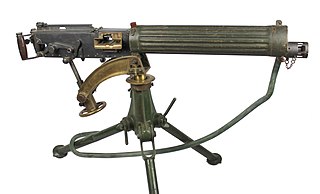
The Vickers machine gun or Vickers gun is a water-cooled .303 British (7.7 mm) machine gun produced by Vickers Limited, originally for the British Army. The gun was operated by a three-man crew but typically required more men to move and operate it: one fired, one fed the ammunition, the others helped to carry the weapon, its ammunition, and spare parts. It was in service from before the First World War until the 1960s, with air-cooled versions of it on many Allied World War I fighter aircraft.

The FN Minimi is a Belgian 5.56mm light machine gun, also classified as a squad automatic weapon developed by Ernest Vervier for FN Herstal. Introduced in the late 1970s, it is in service in more than 75 countries. The weapon is manufactured at the FN facility in Herstal and their U.S. subsidiary FN Manufacturing LLC.

A magazine, often simply called a mag, is an ammunition storage and feeding device for a repeating firearm, either integral within the gun or externally attached. The magazine functions by holding several cartridges within itself and sequentially pushing each one into a position where it may be readily loaded into the barrel chamber by the firearm's moving action. The detachable magazine is sometimes colloquially referred to as a "clip", although this is technically inaccurate since a clip is actually an accessory device used to help load ammunition into a magazine or cylinder.

The PK is a belt-fed general-purpose machine gun, chambered for the 7.62×54mmR rimmed cartridge.

The MG 3 is a German general-purpose machine gun chambered for the 7.62×51mm NATO cartridge. The weapon's design is derived from the World War II era MG 42 that fired the 7.92×57mm Mauser round.
The Spencer repeating rifles and carbines were 19th-century American lever-action firearms invented by Christopher Spencer. The Spencer was the world's first military metallic-cartridge repeating rifle, and over 200,000 examples were manufactured in the United States by the Spencer Repeating Rifle Co. and Burnside Rifle Co. between 1860 and 1869. The Spencer repeating rifle was adopted by the Union Army, especially by the cavalry, during the American Civil War but did not replace the standard issue muzzle-loading rifled muskets in use at the time. Among the early users was George Armstrong Custer. The Spencer carbine was a shorter and lighter version designed for the cavalry.
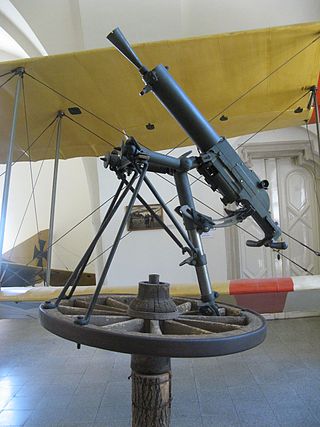
The Maschinengewehr (Schwarzlose) M. 7, also known as the Schwarzlose MG, is a medium machine-gun, used as a standard issue firearm in the Austro-Hungarian Army throughout World War I. It was utilized by the Dutch, Greek and Hungarian armies during World War II. It was routinely issued to Italian colonial troops, alongside the Mannlicher M1895 rifle.

Service Dress is the style of khaki service dress uniform introduced by the British Army for use in the field from the early 1900s, following the experiences of a number of imperial wars and conflicts, including the Second Boer War. This variant of uniform continues to be worn today, although only in a formal role, as No. 2 Pattern dress.

An assault rifle is a select fire rifle that uses an intermediate-rifle cartridge and a detachable magazine. Assault rifles were first put into mass production and accepted into widespread service during World War II. The first assault rifle to see major usage was the German StG 44, a development of the earlier Mkb 42. While immediately after World War II, NATO countries were equipped with battle rifles, the development of the M16 rifle during the Vietnam War prompted the adoption of assault rifles by the rest of NATO. By the end of the 20th century, assault rifles had become the standard weapon in most of the world's armies, replacing full-powered rifles and submachine guns in most roles. The two most successful modern assault rifles are the AK-47 and the M16 designs and their derivatives.

The M249 SAW, formally written as Light Machine Gun, 5.56 mm, M249, is the US military’s adaptation of the Belgian FN Minimi, a light machine gun manufactured by FN Herstal (FN).

1937 Pattern Web Equipment was an item of military load-carrying equipment. It replaced the 1908 Pattern and 1925 Pattern—on which it was based—and was standard issue for British and Commonwealth troops from its introduction in 1937, throughout World War II, and in the post-war period until it was superseded by 1958 Pattern Web Equipment. It remained in limited use with Territorial Army and other second-line troops until the mid to late 1970s. Official use of the webbing in Community Cadet Forces and the Combined Cadet Force persisted into the 1980s.
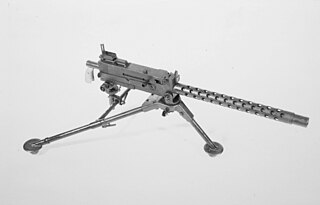
The M1919 Browning is a .30 caliber medium machine gun that was widely used during the 20th century, especially during World War II, the Korean War, and the Vietnam War. The M1919 saw service as a light infantry, coaxial, mounted, aircraft, and anti-aircraft machine gun by the U.S. and many other countries.
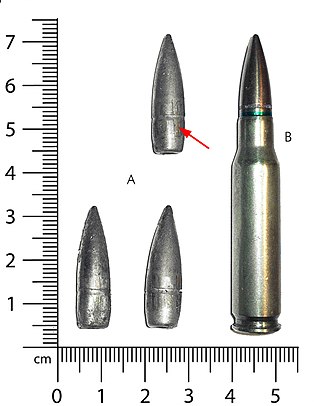
The 7.62×51mm NATO is a rimless, bottlenecked rifle cartridge. It is a standard for small arms among NATO countries.

The 1908 Pattern Web Infantry Equipment was an innovative type of webbing equipment adopted by the British Army before World War I.
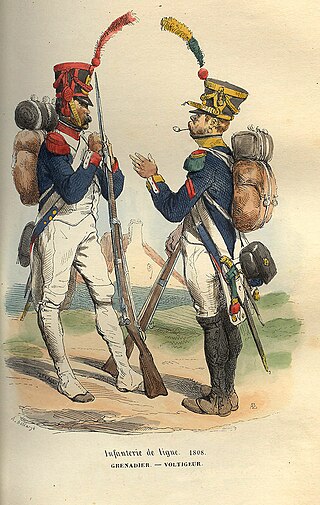
In military uniforms, a shoulder belt is a wide belt worn usually over the shoulder and across the body. With nearly all line infantry, skirmishers, light infantry, grenadiers and guard regiments, two shoulder belts were worn - one carrying the cartridge box, and another for the bayonet, a sword, or other military equipment.